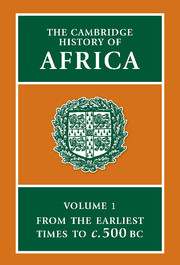Book contents
- Frontmatter
- 1 The palaeo-ecology of the African continent: the physical environment of Africa from earliest geological to Later Stone Age times
- 2 Origins and evolution of African Hominidae
- 3 The earliest archaeological traces
- 4 The cultures of the Middle Palaeolithic/Middle Stone Age
- 5 The Late Palaeolithic and Epi-Palaeolithic of northern Africa
- 6 The Later Stone Age in sub-Saharan Africa
- 7 The rise of civilization in Egypt
- 8 Beginnings of pastoralism and cultivation in north-west Africa and the Sahara: origins of the Berbers
- 9 The origins of indigenous African agriculture
- 10 Old Kingdom, Middle Kingdom and Second Intermediate Period in Egypt
- 11 Early food production in sub-Saharan Africa
- 12 Egypt, 1552–664 BC
- Bibliographical essays
- Bibliography
- Index
- Fig. 3.5 The distribution of sites known or believed to be older than 1.5 million years (i.e. Oldowan). (Modified from J. D. Clark 1967.)
- Fig. 3.6 The distribution of sites known or believed to be between 1.5 and 0.7 million years (i.e. Early Acheulian and Developed Oldowan).">
- Fig. 3.7 The location of Earlier Stone Age and Lower Palaeolithic sites thought to be between 0.7 and 0.1 million years old (i.e. Acheulian plus Developed Oldowan/Hope Fountain).
- Fig. 3.16 The ‘Zinjanthropus’ site at FLK, Bed I, Olduvai Gorge. A plan showing the distribution of an old ground–surface which was uncovered by excavation. A dense patch of discarded artifacts and introduced stones (manuports) coincides with a dense patch of broken–up animal bones. (After M. D. Leakey 1971.)
- Plate Section
- Plate Section
- Plate Section
- Plate Section">
- Plate Section
- Plate Section
- Plate Section
- References
7 - The rise of civilization in Egypt
Published online by Cambridge University Press: 28 March 2008
- Frontmatter
- 1 The palaeo-ecology of the African continent: the physical environment of Africa from earliest geological to Later Stone Age times
- 2 Origins and evolution of African Hominidae
- 3 The earliest archaeological traces
- 4 The cultures of the Middle Palaeolithic/Middle Stone Age
- 5 The Late Palaeolithic and Epi-Palaeolithic of northern Africa
- 6 The Later Stone Age in sub-Saharan Africa
- 7 The rise of civilization in Egypt
- 8 Beginnings of pastoralism and cultivation in north-west Africa and the Sahara: origins of the Berbers
- 9 The origins of indigenous African agriculture
- 10 Old Kingdom, Middle Kingdom and Second Intermediate Period in Egypt
- 11 Early food production in sub-Saharan Africa
- 12 Egypt, 1552–664 BC
- Bibliographical essays
- Bibliography
- Index
- Fig. 3.5 The distribution of sites known or believed to be older than 1.5 million years (i.e. Oldowan). (Modified from J. D. Clark 1967.)
- Fig. 3.6 The distribution of sites known or believed to be between 1.5 and 0.7 million years (i.e. Early Acheulian and Developed Oldowan).">
- Fig. 3.7 The location of Earlier Stone Age and Lower Palaeolithic sites thought to be between 0.7 and 0.1 million years old (i.e. Acheulian plus Developed Oldowan/Hope Fountain).
- Fig. 3.16 The ‘Zinjanthropus’ site at FLK, Bed I, Olduvai Gorge. A plan showing the distribution of an old ground–surface which was uncovered by excavation. A dense patch of discarded artifacts and introduced stones (manuports) coincides with a dense patch of broken–up animal bones. (After M. D. Leakey 1971.)
- Plate Section
- Plate Section
- Plate Section
- Plate Section">
- Plate Section
- Plate Section
- Plate Section
- References
Summary
ORIENTATION
Through Pharaonic Egypt, Africa lays claim to being the cradle of one of the earliest and most spectacular civilizations of antiquity. The aim of this chapter is to trace the development of this civilization from the introduction of a south-west Asian-style subsistence economy into the Nile Valley to its florescence at the beginning of the Old Kingdom, conventionally dated about 2700 B.C. Egyptologists conventionally divide this span into a Predynastic Period, prior to the traditional First Dynasty of the Egyptian chronicler Manetho, and a subsequent Early Dynastic Period, which corresponds with Manetho's first two dynasties. This division has been justified by assuming that the beginning of the First Dynasty corresponded with the political unification of Egypt and marked a critical break in Egyptian history. While it is evident that political unification played a major long-term role in shaping the cultural patterns of ancient Egypt, this achievement was part of a continuum of social and cultural change that was well advanced in late Predynastic times and reached its culmination in the Old Kingdom. Because of this, it is profitable to view the entire formative period of Egyptian civilization as a single unit.
Although the Egyptian script was developed during the Early Dynastic Period, written sources for this period are extremely limited and present numerous epigraphic difficulties. Even the succession of kings and the identifications of the royal Horus-names appearing on the monuments of this period with the nebty- or insibya- names given in the later king-lists are far from certain in many cases (see appendix, p-547).
Keywords
- Type
- Chapter
- Information
- The Cambridge History of Africa , pp. 478 - 547Publisher: Cambridge University PressPrint publication year: 1982
References
- 3
- Cited by



